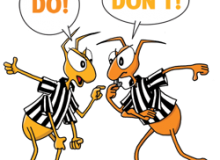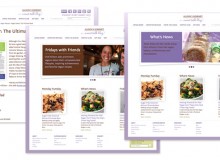 Regardless of whose ad dogma you subscribe to, your goal is singular: cause a positive action. That’s it. Seems pretty simple, doesn’t it? Well, in practice, causing a positive action in a print ad is trickier than you’d think.
Regardless of whose ad dogma you subscribe to, your goal is singular: cause a positive action. That’s it. Seems pretty simple, doesn’t it? Well, in practice, causing a positive action in a print ad is trickier than you’d think.
There are three key tools for creating a great ad or campaign that causes a positive action. These are all of equal weight. Without all three, your ad’s success is in jeopardy.
- Great concept.
- On-target message.
- Flawless execution.
Assuming you’re working with a great team to create a great concept and on-target message, the only thing you have left to worry about is flawless execution.
Great Concept
Your task is to be the exception. Buck the trends. Surprise and delight. Shock and awe—you get the drill. This is where you DON’T want to just keep up with the Joneses.
Anyone can put their product logo, photo and description in a box and call it an ad. But creating an ad that has true stopping power, snagging the reader in the 1.5 seconds they glance at the visual, is incredibly more difficult. Remember, a concept is an instance. Not too heavy, it’s quick and reels in the reader.
(click image to enlarge) I like the contrast of the above two examples for different reasons: Harley uses an insanely long headline whereas Valspar uses only a demure tagline near the chip. They are both perfectly suited to their vastly different markets.
On-target Message
Understanding your target audience and their specific desires is critical to determining the best message for your ad. A great visual will certainly stop them, but you’ve got to follow through with a compelling message. The message is the half-second remaining in the scan time readers will devote to your ad.
In order of importance, your message should be stated by the headline and supported by body text. Today’s consumers will never get to the body text much less your call-to-action unless your main message is a real grabber.
And remember, if your best effort results in hollow platitudes like great customer satisfaction, full ranges of solutions or some other drivel used by the masses, don’t bother. Consumers are more savy than you think and are much more critical than ever before. Most ads sound the same to them and they view you as an interruption to the article they’re reading.
Here are a few examples of what NOT to do from real-life ads (yawn yawn, blah blah blah):
| Message | Product | Why it doesn’t work |
|---|---|---|
| Technology with an edge. | kitchen knives | Technology doesn’t cut my tomatoes, a good knife does. Keep the message focused on the benefit. |
| Why is this considered the most advanced wiper system ever? You’ll see. | windshield wiper blades | They lost me after the ninth syllable. Remember, 1.5 seconds of scanning time is devoted to the visual. That leaves only a mere half-second for the message. Make it efficient. |
| Solatube Solution. | tubular skylights | If I see ‘solution’ used one more time, I think I may hurl. If I want a groovy round skylight, I don’t want a solution. |
| Batteries not included…or needed | electromagnetic flashlight | There’s a germ of an idea with real stopping power here but it seems to have gotten killed by committee. |
Now for a refreshing break, here are a few examples of intriguing messages, again from real-life ads:
| Message | Product | Why it works |
|---|---|---|
| If it doesn’t get dirt, grease or blood under your nails, it’s not a hobby. | Gerber Legend ® Multi-Plier tool | Great extreme close up of cracked fingertips and dirty nails with message squarely targeting the male demographic of The Family Handyman magazine. Finished off with a flawless tagline for the DIYer: Fend for yourself. |
| What’s your carfun footprint? | Mini-Cooper | Twist of words requiring a double take is a good way to stop readers. |
| Looks like someone used too much Miracle-Gro®. | Dodge Ram pick ups | Dead-on to the target market of home and handyman magazines. Coulda had a more powerful visual but this chart is about the message. |
| Regrets cost a lot more.
I coulda got a smart, sensible turdmobile. Six bucks a day. Cheaper than your smokes, a six pack, a lap dance, a bar tab, another tattoo, a parking ticket, a gas station burrito, a lip ring, bail, cheap sunglasses, more black t-shirts. |
Harley-Davidson | Dead-on target. Harley completely gets their target market’s need to consider themselves bad asses.
The third message is the exception to the rule of keeping the message efficient. Remember, there are always exceptions. |
Flawless Execution
The execution component is fraught with a seemingly infinite set of ad rules and guidelines touted by “experts” and based on studies. These rules exist because marketing experts are always in search of absolutes. Unfortunately, there are none. Advertising to humans is by nature not a science. Examples of things that are truly scientific would include our brain’s reaction to specific colors (which is also cultural), our eye’s ability to read tiny type and a myriad of other gray matter-related abilities.
- Rule makers attempt to define the often indefinable to make it available to everyone.
- Rule breakers understand the rules and also how to bend or break them to exceed the ad’s goals.
Let’s look at a couple of typical rules that rule makers like to espouse:
Reversed type in ads doesn’t produce great response. While studies certainly suggest that this is true, we don’t know what ads were used in the studies, we don’t know if their message was on target, we don’t know if their visual had stopping power or even if the designer selected an appropriate typeface at an appropriate size for reversing.
For example, expecting 7 point Bodoni Light Condensed reversed from a 4-color process background on a trade journal’s web press to be successful in an ad is just plain silly. It ain’t gonna happen. But using a typeface with a larger x-height, regular weight like Myriad Pro Regular is safer and much more readable.
Suffice it to say, if you don’t know what you’re doing typographically, this is likely a good rule to follow.
All ads should contain a photo of the product. History has shown that there is likely something to be said for this rule. Remember the Nissan Infiniti launch campaign back in the late 80’s? Designers loved it because it eliminated the car from the ads and was considered edgy/risky. However, keep in mind, this car was developed to compete with Lexus, and Infiniti sales continue to lag. Would the Infiniti have competed better with Lexus if the launch campaign included car photos? We’ll never know for sure.
Lessons Learned
Balancing the need to stop the reader, support the brand and be readable is tricky. If all ads followed all the rules, none would stand out from the pack. Remember, great advertising is about getting attention, stopping the reader, enticing and snaring.
If you’ve got a great ad with stopping power, it’s readable and the message is on target, then likely it will work regardless of what the rules say. But if you’re short on one of the three keys, nothing will save your ad and your budget could be wasted.
But, like any good student, learn the rules before you break them. Know and understand what you’re doing and why.
By Julia Moran Martz







